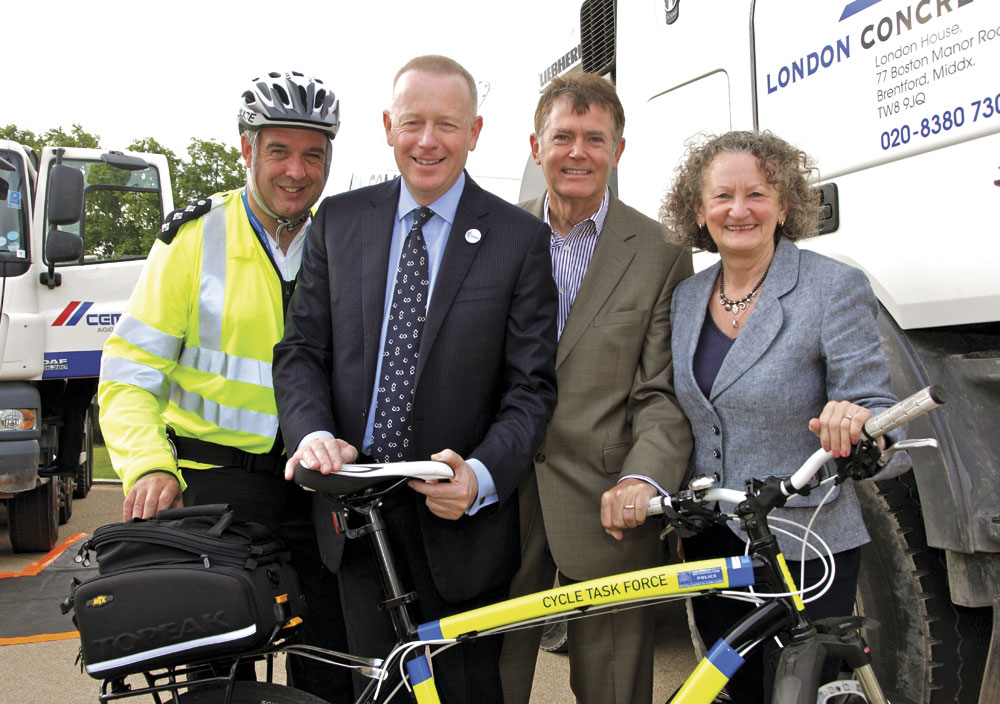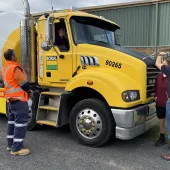Time to Take Action

The MPA’s Cycle Safe campaign aims to minimize hazards and risks for all vulnerable road users
Every year 17,000 cyclists are killed or injured in the UK. In London alone, 16 were killed in 2011 and 13 of these fatalities involved a lorry, van or bus. Transport for London reports that most of these lorries were construction vehicles.
However, this is not just an urban issue – a House of Commons briefing paper reveals that in 2010 there were more cyclist fatalities on rural roads (64 in total) than on urban roads. Rural A-roads had a particularly high cyclist fatality rate and serious injury rate, relative to other road types. Cyclist fatalities and serious injuries also occurred in all English regions, Scotland and Wales, with the number of killed and seriously injured cyclists greatest in the South East, London and the North West.
The Mineral Products Association’s Cycle Safe campaign and 6-Point Action Plan, launched nationally in June 2011 at the Metropolitan Police’s ‘Exchanging Places’ event at Hyde Park Corner, in London, aims to prevent collisions between cyclists and large goods vehicles (LGVs) by raising awareness on both sides of how to cycle and drive as safely as possible. This campaign demonstrates the commitment of the MPA and its members, who operate some 30,000 lorries, to playing their part in minimizing hazards and risks for all road users. The campaign is focused on the whole of the UK and will be rolled out across the regions.
In February 2012 The Times newspaper launched its own safe-cycling campaign after one of its reporters was seriously injured ‰ in a collision with a lorry. This has helped to push cyclist safety high up the public, media and political agenda.
The MPA welcomes The Times’ campaign, which broadly aligns with its own Cycle Safe campaign, and the onus this has placed on all parties – drivers, companies, cyclists, police and regulators – to work together to address the long-term challenge of making the UK’s roads safer.
The fact that there was a 44% increase in ready-mixed concrete sales in Greater London in 2011, which is indicative of a significant increase in construction activity and materials deliveries, might help explain the high number of collisions between cyclists and lorries last year. Overall demand for aggregates, concrete and asphalt is likely to decline across Great Britain this year but trends should start to look more positive from 2013 onwards, which means more industry deliveries on the same roads as more cyclists and other vulnerable road users.
The MPA’s Cycle Safe campaign takes the organization’s commitment to health and safety best practice beyond the confines of the site or plant to encompass everyone who might come into contact with its members’ vehicles. The aim is for Cycle Safe to deliver measurable improvements in health and safety that reflect the achievements already made internally: MPA members are committed to a target of ‘Zero Harm’ for their own employees and, in the 10 years to the end of 2009, reportable injuries reduced by 83%.
The Cycle Safe campaign examines both sides of the story, from the cyclist’s and the driver’s perspective, in order to prevent collisions and raise mutual awareness.
MPA advice to lorry drivers is to:
- Apply cyclist warning signs to vehicles;
- Consider fitting equipment such as: special mirrors, cameras, audible warnings, sideguards, side-sensors;
- Attend vulnerable road-user training;
- And be aware of cyclists.
MPA advice to cyclists is to:
- Never undertake a lorry – it may be about to turn left (the same is true even if you are in a cycle lane);
- And always remember:
- A large lorry may well swing right in order to turn left
- Be visible, be confident and signal clearly
- Do not ignore traffic lights and do not get distracted by a phone or MP3 player
- A lorry driver may have blind spots around his vehicle, so he may not see you
- Try to make eye contact with a lorry driver for the sake of mutual awareness.
The MPA’s 6-Point Cycle Safe Action Plan
The MPA’s 6-Point Cycle Safe Action Plan, which is at the heart of the campaign, is as follows:
1. Promote driver and industry awareness
Actions to Date: The MPA has used internal communications, such as newsletters and briefings, to raise its members’ awareness of cyclist/driver safety issues and to promote the resources available to them to support the campaign – leaflets, stickers, a mirror mat, among other things.
A facilitated Exchange, attended by 30 member companies from across the membership, was organized by the MPA on 6 March 2012 to examine how to reduce collisions with vulnerable road users. The Exchange gathered views from the membership and shared experiences on a number of issues. It will inform MPA policy going forward.
2. Promote cyclist and public awareness
Action to date: A successful pilot MPA Cycle Safe event was held in Oxford in March 2011, backed by key stakeholders, including Oxford University Estates, Thames Valley Police, Oxford City Council, Oxfordshire County Council and Oxford Cycle Workshop Training. This was followed by the national launch of the Cycle Safe campaign at the Metropolitan Police’s Hyde Park Corner ‘Exchanging Places’ event in June 2011.
Members of the MPA have also been providing ongoing support for further Metropolitan Police ‘Exchanging Places’ events, which allow cyclists to sit in the cab of a lorry and see the road from the driver’s perspective. Since December 2012, MPA members have supported nine of these events.
3. Improve driver training
Action to date: The MPA is working with training providers to develop a specific CPC-approved module on cyclist safety and vulnerable road users.
In addition, the existing Driver Skills course, which all delivery drivers for MPA members are required to take, has now been extended to cover all vehicle types in the sector and includes cyclist awareness training. This training has been undertaken by 27,500 drivers to date.
4. Encourage members to use appropriate technological adaptations to minimize risks to cyclists and exchange experience
Action to date: The MPA has issued guidance to members on available vehicle safety equipment designed to minimize the risk of collisions with cyclists and vulnerable road users. The facilitated Cycle Safe Exchange between members also generated valuable feedback on the performance of such safety equipment. The result is that a range of equipment has been reviewed by an MPA working group, with a view to developing a minimum standard/recommendations for members.
5. Liaise with schools
Action to Date: The MPA has learnt from members’ experiences of working with schools and has issued guidance to members on running school Cycle Safe events.
6. Improve driver training
Action to date: The MPA is a member of the Department for Transport’s Cycle Safety Stakeholder Group and has been invited to join Transport for London’s Cycle Safety Group. The Association is also contributing to Transport for London’s research project into Construction Logistic Operations and the Safety of Cyclists. The MPA has initiated liaison with the London Cycling Campaign, the Cyclists’ Touring Club, Transport for London, the Department for Transport, the Freight Transport Association and the Road Haulage Association.
Furthermore, the MPA now has Associate membership of Transport for London’s Freight Operator Recognition Scheme (FORS), to which several of the Association’s members already belong.
What next?
Two major goals for 2012 are to launch a new CPC-approved driver training module on cyclist safety and vulnerable road users; and to issue the minimum standard/recommendations on safety equipment for members’ vehicles.
A 2012 London campaign relaunch event is being planned to tie in with the MPs Cycle Ride in the summer. Events in Cambridge, Leicester and other cities supporting The Times’ campaign are also being organized, while members are offering sustained support for the Metropolitan Police’s ‘Exchanging Places’ events.
One practical reason why the MPA is getting involved is that there is a distinct possibility of a proliferation of contract requirements requiring the delivery chain to demonstrate an awareness of vulnerable road-user safety, a commitment to driver training and specific equipment levels for delivery vehicles. The Crossrail contract in London includes onerous conditions for the whole delivery chain and these requirements are beginning to spread to other contracts. The MPA wants to ensure that there is a practical and workable general approach to vulnerable road-user requirements for delivery vehicles from contractors and clients across the UK, and the industry demonstrating a commitment to helping to reduce road fatalities and serious injuries is an important part of this process.
The MPA has several resources available for members, including Cycle Safe leaflets and stickers.
MPA chief executive Nigel Jackson said: ‘The MPA will continue to publicize the importance of cyclist and driver safety and engage with its members on this issue, as well as promote the campaign resources which are at members’ disposal and encourage members to work with schools. We will be developing closer relationships with stakeholders on Cycle Safe, including cycling bodies and government departments.
‘MPA members want to be at the forefront of helping to improve road safety and we aim to build on our work to date to ensure we play a key part.’
For further information contact the MPA on tel: (0207) 963 8000; or email: info@mineralproducts.org








